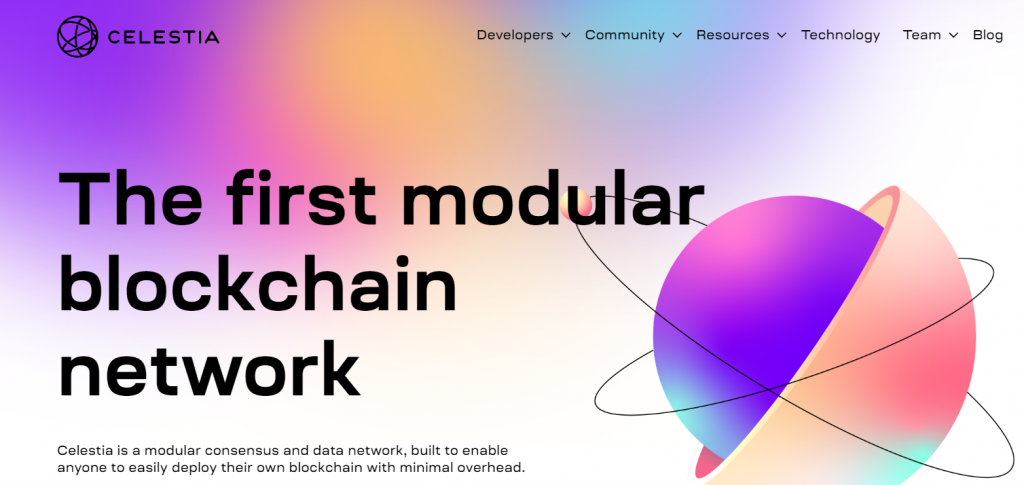Modular blockchains focus only on specific tasks and offload the rest to other layers. Celestia is one of the examples of such blockchain projects.
When it comes to network scalability and blockchain infrastructure, the concept of modular blockchain is becoming the new story. Modular blockchains allow the design of principled separation of concerns to scale throughput.
It also breaks the relationship between computational cost and verification cost. In this article, we take a closer look at modular blockchains, how they work, and Celestia. Let’s dive in!
What is a Modular Blockchain?
Simply put, modular blockchains focus only on specific tasks and offload the rest to other layers. To gain a deeper understanding, we first need to assess the usual blockchain tasks: consensus, execution, data availability, and settlement.
- Consensus
Consensus refers to the mechanism by which nodes agree on which data on the blockchain can be verified as true and accurate. A consensus protocol determines how transactions are ordered and new blocks are added to the chain.
- Execution
Execution is how nodes on the blockchain process transactions to transition the blockchain between states. Nodes participating in consensus must execute and confirm transactions using a copy of the blockchain before validating a block.
- Data availability
Blockchain enforces rules that require the availability of transactional data. In other words, block producers must publish data for each block for network partners to download and store. This data must be provided upon request.
- Settlement
Finally, blockchain offers “finality”. This ensures that transactions committed to the history of the chain are irreversible (or “immutable”). To do this, the blockchain must be certain of the validity of the transaction. Therefore, payment functions require the chain to validate transactions, verify evidence, and arbitrate disputes.
Now that we’ve explored the main features of blockchain, let’s see how modular blockchain design works.
Before that, Here’s an in-depth thread about modular blockchains which answers the modularity of the current market and its architecture. Give it a read!
How does Modular Blockchain work?
Modular blockchains work on the principle of modularity, which refers to dividing a system into different components that can be combined in different ways to achieve a specific goal. Modularization requires specialization. Each component can only do a few things, but it has to be good at it. You can think of modular components like Lego blocks that can be combined into different structures.
Modular Chains are components within a larger “modular stack” of blockchains that can be combined to achieve different goals. Modular blockchains act as “pluggable modules” that can be swapped or merged depending on the use case.
Sharding and Rollups in modular context
Sharding
Sharding is the process of dividing a system (such as a database) into pieces that work. By dividing the functionality into several components, the system achieves higher performance and efficiency than if all parts worked together on the same task. In a blockchain network, sharding divides the blockchain into multiple subchains, each handling a different portion of network activity.
Ethereum employs a shard design with e64 shard chains running in parallel. A shard can process transactions in parallel (execution sharding) or act as a “repository” for storing different blocks of blockchain data (data sharding). With data sharding, an Ethereum node only stores data published to its shard chain. This is in contrast to the current structure where all nodes must store the same data.
Rollups
Some developers are taking a rollup-centric approach to scale Ethereum. Unlike pure off-chain scaling solutions like sidechains, rollups are tightly coupled to the parent chain. Rather, rollups are extensions of the main chain designed to scale throughput to the latter.
The Ethereum blockchain offloads computation to rollups and focuses on payments, consensus, and data availability. Rollups can aggressively optimize execution by reducing block times and making blocks larger without sacrificing decentralization or security. This is because Ethereum serves as the base layer (or “Layer 1”) of the rollup on top of Layer 2.
Advantages of Modular Blockchain
- Scalability
The blockchain trilemma states that a blockchain can only have two of the three possible properties and cannot have all three at the same time: decentralization, security, and scalability. Optimizing for one particular quality (scalability) leads to compromises in other areas (security and decentralization). This is why blockchain scaling is difficult.
However, the scaling problem mostly arises when the blockchain tries to handle all the activity in one layer at a time. Applying modularity to the blockchain (separating tasks between different layers) improves scaling without introducing unsound assumptions of trust. For example, execution-focused rollups offer better scalability than regular chains. Still, relying on Ethereum for consensus and data availability provides a high level of security.
- Launching new Blockchains
Launching a new blockchain can be difficult as security features need to be built in. Proof-of-stake chains may need to establish a wide distribution of tokens to avoid the risk of centralization. On the other hand, a proof-of-work chain may need to attract miners to prevent a small number of parties from damaging the network’s hash rate checks.
But what if developers could focus on the bare minimum? You can add another modular blockchain component that performs a specific task, such as execution. Security, what do you do? By leveraging modular design, new blockchains can be launched more quickly without worrying if all parts of the architecture are correct.
- Flexibility
Modularity provides flexibility that a monolithic chain cannot provide. Bitcoin’s focus on decentralization and security automatically eliminates scalability, but high-throughput chains often sacrifice decentralization and security to some extent.
The dedicated modular chain offers greater flexibility regarding trade-offs and design implementation. For example, a modular blockchain system might include a modular chain focused on security and data availability, while others focus on execution. Here’s how both benefit from a modular design. Security and data availability layers benefit from additional scalability because transactions are processed independently. You just need to enforce the validity of off-chain execution and guarantee the availability of off-chain data. Here’s how using rollups gives Ethereum scalability. The execution layer (optimized for scalability) benefits from additional security by leveraging the properties of the parent chain. This is how Layer 2 benefits from the decentralization of Ethereum.
Limitations of a Modular Blockchain
- Security
Unlike a monolithic chain, a modular chain cannot guarantee its own security. If the security layer (which typically handles consensus and data availability) is ineffective, modular chains risk failing.
- Complexity
Implementing a modular blockchain design introduces new complexities. For example, Ethereum’s data sharding plan relies on data availability sampling to ensure that no node on a shard holds data. Similarly, the execution layer requires certain complex mechanisms such as Fraud proof and verification that allows the security layer to enforce the validity of off-chain state transitions.
The token Value of some modular chains may not be able to attract native token value due to their limited use. For example, a layer that focuses solely on consensus and data availability may have less utility use of her tokens than an execution layer. Also, attracting participants to such networks can be more difficult.
Celestia – The First Modular Blockchain Network

Celestia applies a modular architecture that separates the blockchain stack into specialized components. The core consensus and executive functions are split into different layers.
Monolithic architecture can be limited. Consensus functionality and execution functionality are bundled into one layer, and smart contracts are built on top of that bundled layer. The user is confined to one execution environment, which limits the optimization and specialization possibilities for his case for a particular use. The modular architecture separates consensus and execution into separate layers. The execution layer lives on its own blockchain, allowing optimization and specialization for specific use cases. Developers creating distributed applications built on top of this architecture enjoy greater flexibility, security, and scalability.
With modular blockchains, sampling of data availability is feasible, allowing nodes to verify blocks with small samples such as To validate a 100 MB block with only 10 KB of data. Machines with minimal computing power, such as smartphones, can act as nodes. When a developer builds dApps directly on her Celestia, she can choose which execution environment to use and run any number of execution environments in parallel. In a monolithic environment, consensus binds execution rules. That is, the user is bound to an execution environment that supports the base chain.
Celestia is still in early development. The development team has released MVP in 2021 and devnet in November 2021. 2022 will be even more important as the project launches its testnet and gradually builds its mainnet.
Conclusion
Scalability is one of the biggest obstacles to the full adoption of blockchain technology. There are several Layer 1 scaling solutions, but most focus on block generation rather than block verification. Celestia, the first modular blockchain network with scalability, security and decentralization capabilities, is ready for Web 3. Celestia is not the only solution. Because Polygon is available and Ethereum is working hard on it. However, Celestia is unique in its focus on easy integration, rapid deployment, and user experience.
Subscribe to get notified on latest posts.




























